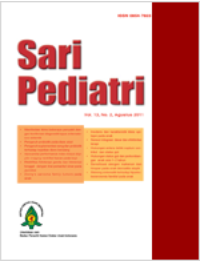High Sensitivity C-Reactive Protein sebagai Parameter Diagnostik dan Prediktor Luaran Sepsis pada Anak yang Menderita Systemic Inflammatory Response Syndrome
Sari
Latar belakang. Sepsis merupakan salah satu penyebab morbiditas dan mortalitas pada anak. Diagnosis
sepsis ditegakkan berdasarkan gejala Systemic Inflammatory Response Syndrome (SIRS) dan penemuan bakteri
pada kultur darah. Kultur bakteri darah memiliki sensitifitas yang rendah dan membutuhkan waktu yang
lama sehingga sering menyebabkan terjadinya overdiagnosis dan overtreatment. C-reactive protein adalah
reaktan fase akut yang kadarnya meningkat pada keadaan infeksi. High sensitivity C-reactive protein (hs-
CRP) adalah metode yang lebih sensitif untuk mengukur kadar CRP dalam jumlah kecil.
Tujuan. Mengetahui peran hs-CRP sebagai parameter diagnostik dan prediktor luaran sepsis pada anak
yang menderita SIRS.
Metode. Penelitian uji diagnostik dengan desain potong lintang terhadap 85 anak dengan gejala SIRS berusia
1 bulan sampai dengan 15 tahun dan dirawat di bangsal anak RS.Dr.M.Djamil Padang sejak Juni sampai
November 2012. Pemeriksaan hs-CRP dilakukan dengan metode enzyme-linked immunosorbent assay (ELISA).
Data dianalisis dengan SPSS serta dilakukan uji diagnostik. Baku emas sepsis adalah biakan darah.
Hasil. Cut off point hs-CRP untuk menentukan sepsis adalah 15,55 ng/ml, (sensitivitas 90,9% dan spesivisitas
53,8%). Kadar rata-rata hs-CRP meningkat sesuai dengan beratnya penyakit.
Kesimpulan. High sensitivity C-reactive protein dapat dijadikan sebagai parameter diagnostik sepsis pada
pasien SIRS dengan cut off point 15,55 ng/ml, serta dapat dipakai sebagai prediktor luaran sepsis.
Kata Kunci
Teks Lengkap:
PDFReferensi
Pavare J, Grope I, Gardovska D. Prevalence of systemic
inflammatory response syndrome (SIRS) in hospitalized
children: a point prevalence study. BMC Pediatr
;25:1-6.
Goldstein B, Giroir, Randolph A, The Members of the
International consensus conference on pediatric sepsis.
International pediatric sepsis consensus conference:
definitions for sepsis and organ dysfunction in pediatrics.
Pediatr Crit Care Med 2005;6(Suppl 3): 2-8.
Short MA. Linking the sepsis triad of inflammation,
coagulation, and suppressed fibrinolysis to infants. Adv
Neonatal Care 2004;5:258-73.
Enrione MA, Powell KR. Sepsis, septic shock, and systemic
inflammatory response syndrome. Dalam: Kliegman RM,
Behrman RE, Jenson HB, Stanton BF, penyunting. Nelson
textbook of pediatrics. Edisi ke-18. Philadelphia:Saunders;
h.1094-9.
Thomas NJ, Tamburro RF, Hall MW, Rajasekaran S,
Venglarcik JS. Bacterial sepsis and mechanisms of microbial
pathogenesis. Dalam: Nichols DG, penyunting. Roger’s
Textbook of Pediatric Intensive Care. Edisi ke-4. Baltimore:
Lippincott Williams & Wilkins; 2008. h.477-88.
Ventetuolo CE, Levy MM. Biomarkers: diagnosis and
risk assessment in sepsis. Clin chest med J 2008:h.591-
Pavare J, Grope I, Eihvalde L, Gardovska D. Diagnostic
markers for identifying sepsis in patients with systemic
inflammatory response syndrome (SIRS): A Prospective
Study. The Open Pediatr Med J 2009;3:1-7.
Castellheim A, Brekke O-L, Espevik§ T, Harboe M,
Mollnes T. Innate immune responses to danger signals
in systemic inflammatory response syndrome and sepsis.
J Imuno 2009;69:479–91.
Standage SW, Wong HR. Biomarkers for pediatric sepsis and septic shock. Expert Rev. Anti Infect. Ther
;9:71–9.
Human high sensitivity C-Reactive protein (hs-CRP)
ELISA Kit. Diakses tanggal 4 Februari 2012. Didapat
dari : http://www.Hs CRP.
Stolz D, Stulz A, Muller B, Gratwohl A, Tamm M.
BAL neutrophils, serum procalcitonin, and C-Reactive
Protein to predict bacterial infection in the immunocompromised
host. Chest.2007;132:504-14.
Bactec Ped Plus Catalog. Diakses tanggal 08 Februari
Didapat dari: www.bactec.com.
Grenc MG, Ihan A, Arnol MP, Kopitar AN, Stopar TG,
Derganc M. Neutrophil and monocyte CD64 indexes,
lipopolysaccharide-binding protein, procalcitonin and
C-reactive protein in sepsis of critically ill neonates and
children. Int Care Med J 2009;35:1950–58.
Galetto-Lacour A, Zamora SA, Gervaix A. Bedside
procalcitonin and C-Reactive Protein tests in children
with fever without localizing signs of infection seen in a
referral center. AAP J 2003;112:1054-60.
Carcillo JA, Planquois JM, Goldstein B. Early markers
of infection and sepsis in newborns and children. Adv
Sepsis 2006;5:118-25.
Pulliam PN, Attia MW, Cronan KM. M. Cronan
undetectable serious bacterial infection C-reactive
protein in febrile children 1 to 36 months of age with
clinically undetectable serious bacterial infection. Pediatr
J 2001;108:1275.
Puopolo KM. Bacterial and fungal infections. Dalam:
Cloherty JP, Stark AR, penyunting. Manual of neonatal
care. Edisi ke-5. Boston: Lippincott Williams & Wilkins;
h.287-312.
DOI: http://dx.doi.org/10.14238/sp16.4.2014.278-83
Refbacks
- Saat ini tidak ada refbacks.
##submission.copyrightStatement##
##submission.license.cc.by-nc-sa4.footer##
Email: editorial [at] saripediatri.org


Sari Pediatri diterbitkan oleh Badan Penerbit Ikatan Dokter Anak Indonesia
Ciptaan disebarluaskan di bawah Lisensi Creative Commons Atribusi-NonKomersial-BerbagiSerupa 4.0 Internasional.




